A Study on the Effects of Prozac on Injured Athletes' Recovery
VerifiedAdded on 2021/04/17
|13
|6421
|390
Report
AI Summary
This report investigates the effects of Prozac, an antidepressant also known as fluoxetine, on injured athletes, particularly in the context of sports-related brain injuries and associated psychological distress. The study aims to determine if Prozac can aid in recovery, reduce depression, and improve outcomes for athletes. The research design involves comparing a treatment group receiving Prozac to a placebo group, assessing recovery rates, and examining potential side effects. The report also reviews existing literature on antidepressants, the psychological impact of injuries on athletes, and the importance of addressing mental health in sports. It addresses the problem of depression in injured athletes, the lack of research in this area, and the potential benefits of Prozac in alleviating psychological symptoms. The research plan includes physical examinations, interviews with medical officers, and an intention-to-treat analysis to ensure unbiased comparisons. The study hypothesizes that Prozac will improve depression recovery rates and explores the relationship between dosage and recovery, with the goal of understanding the drug's impact on athletes' mental and physical well-being.

The Effects of Prozac as Anti-Depressant on Injured Athletes
Paraphrase This Document
Need a fresh take? Get an instant paraphrase of this document with our AI Paraphraser
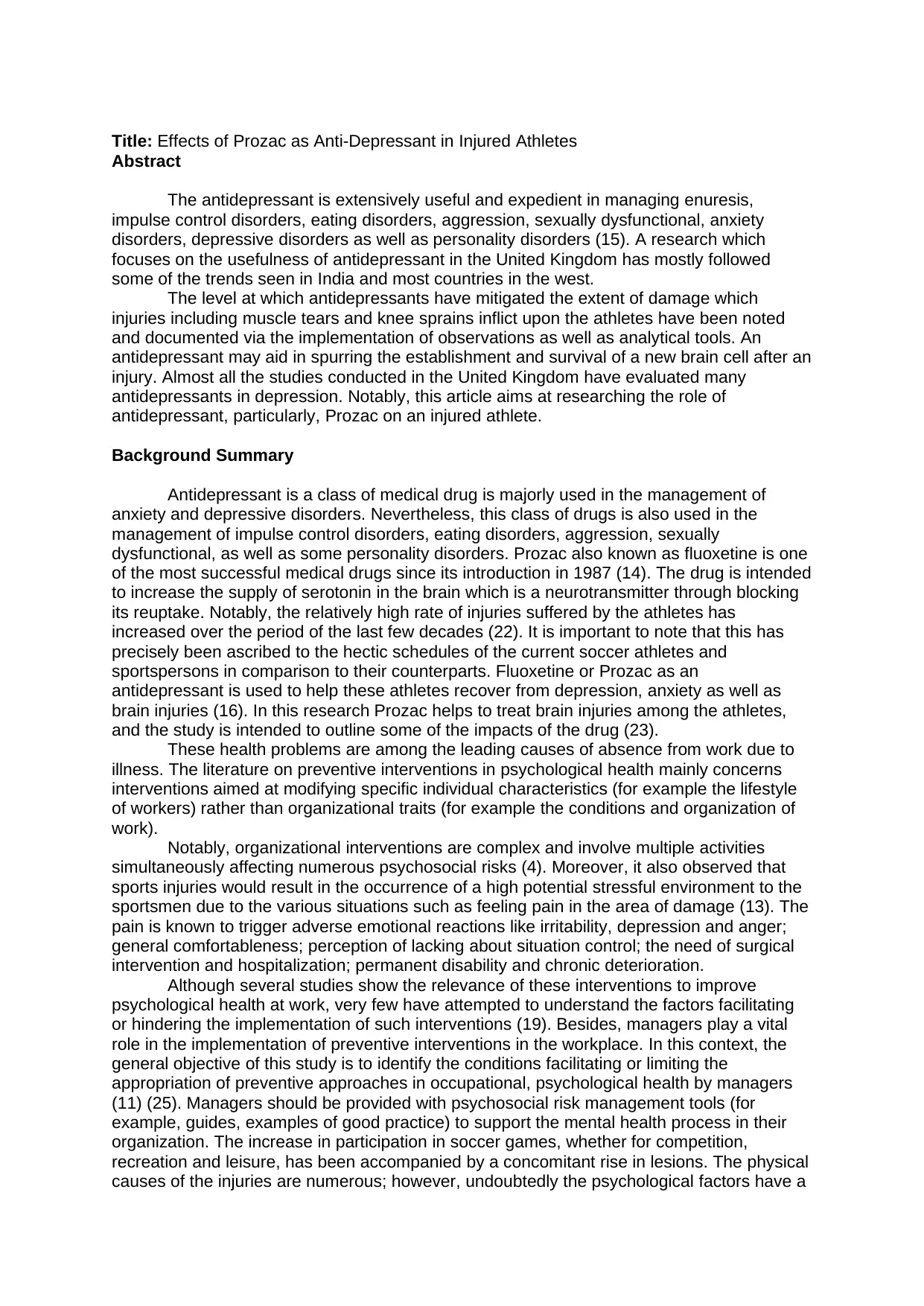
Title: Effects of Prozac as Anti-Depressant in Injured Athletes
Abstract
The antidepressant is extensively useful and expedient in managing enuresis,
impulse control disorders, eating disorders, aggression, sexually dysfunctional, anxiety
disorders, depressive disorders as well as personality disorders (15). A research which
focuses on the usefulness of antidepressant in the United Kingdom has mostly followed
some of the trends seen in India and most countries in the west.
The level at which antidepressants have mitigated the extent of damage which
injuries including muscle tears and knee sprains inflict upon the athletes have been noted
and documented via the implementation of observations as well as analytical tools. An
antidepressant may aid in spurring the establishment and survival of a new brain cell after an
injury. Almost all the studies conducted in the United Kingdom have evaluated many
antidepressants in depression. Notably, this article aims at researching the role of
antidepressant, particularly, Prozac on an injured athlete.
Background Summary
Antidepressant is a class of medical drug is majorly used in the management of
anxiety and depressive disorders. Nevertheless, this class of drugs is also used in the
management of impulse control disorders, eating disorders, aggression, sexually
dysfunctional, as well as some personality disorders. Prozac also known as fluoxetine is one
of the most successful medical drugs since its introduction in 1987 (14). The drug is intended
to increase the supply of serotonin in the brain which is a neurotransmitter through blocking
its reuptake. Notably, the relatively high rate of injuries suffered by the athletes has
increased over the period of the last few decades (22). It is important to note that this has
precisely been ascribed to the hectic schedules of the current soccer athletes and
sportspersons in comparison to their counterparts. Fluoxetine or Prozac as an
antidepressant is used to help these athletes recover from depression, anxiety as well as
brain injuries (16). In this research Prozac helps to treat brain injuries among the athletes,
and the study is intended to outline some of the impacts of the drug (23).
These health problems are among the leading causes of absence from work due to
illness. The literature on preventive interventions in psychological health mainly concerns
interventions aimed at modifying specific individual characteristics (for example the lifestyle
of workers) rather than organizational traits (for example the conditions and organization of
work).
Notably, organizational interventions are complex and involve multiple activities
simultaneously affecting numerous psychosocial risks (4). Moreover, it also observed that
sports injuries would result in the occurrence of a high potential stressful environment to the
sportsmen due to the various situations such as feeling pain in the area of damage (13). The
pain is known to trigger adverse emotional reactions like irritability, depression and anger;
general comfortableness; perception of lacking about situation control; the need of surgical
intervention and hospitalization; permanent disability and chronic deterioration.
Although several studies show the relevance of these interventions to improve
psychological health at work, very few have attempted to understand the factors facilitating
or hindering the implementation of such interventions (19). Besides, managers play a vital
role in the implementation of preventive interventions in the workplace. In this context, the
general objective of this study is to identify the conditions facilitating or limiting the
appropriation of preventive approaches in occupational, psychological health by managers
(11) (25). Managers should be provided with psychosocial risk management tools (for
example, guides, examples of good practice) to support the mental health process in their
organization. The increase in participation in soccer games, whether for competition,
recreation and leisure, has been accompanied by a concomitant rise in lesions. The physical
causes of the injuries are numerous; however, undoubtedly the psychological factors have a
Abstract
The antidepressant is extensively useful and expedient in managing enuresis,
impulse control disorders, eating disorders, aggression, sexually dysfunctional, anxiety
disorders, depressive disorders as well as personality disorders (15). A research which
focuses on the usefulness of antidepressant in the United Kingdom has mostly followed
some of the trends seen in India and most countries in the west.
The level at which antidepressants have mitigated the extent of damage which
injuries including muscle tears and knee sprains inflict upon the athletes have been noted
and documented via the implementation of observations as well as analytical tools. An
antidepressant may aid in spurring the establishment and survival of a new brain cell after an
injury. Almost all the studies conducted in the United Kingdom have evaluated many
antidepressants in depression. Notably, this article aims at researching the role of
antidepressant, particularly, Prozac on an injured athlete.
Background Summary
Antidepressant is a class of medical drug is majorly used in the management of
anxiety and depressive disorders. Nevertheless, this class of drugs is also used in the
management of impulse control disorders, eating disorders, aggression, sexually
dysfunctional, as well as some personality disorders. Prozac also known as fluoxetine is one
of the most successful medical drugs since its introduction in 1987 (14). The drug is intended
to increase the supply of serotonin in the brain which is a neurotransmitter through blocking
its reuptake. Notably, the relatively high rate of injuries suffered by the athletes has
increased over the period of the last few decades (22). It is important to note that this has
precisely been ascribed to the hectic schedules of the current soccer athletes and
sportspersons in comparison to their counterparts. Fluoxetine or Prozac as an
antidepressant is used to help these athletes recover from depression, anxiety as well as
brain injuries (16). In this research Prozac helps to treat brain injuries among the athletes,
and the study is intended to outline some of the impacts of the drug (23).
These health problems are among the leading causes of absence from work due to
illness. The literature on preventive interventions in psychological health mainly concerns
interventions aimed at modifying specific individual characteristics (for example the lifestyle
of workers) rather than organizational traits (for example the conditions and organization of
work).
Notably, organizational interventions are complex and involve multiple activities
simultaneously affecting numerous psychosocial risks (4). Moreover, it also observed that
sports injuries would result in the occurrence of a high potential stressful environment to the
sportsmen due to the various situations such as feeling pain in the area of damage (13). The
pain is known to trigger adverse emotional reactions like irritability, depression and anger;
general comfortableness; perception of lacking about situation control; the need of surgical
intervention and hospitalization; permanent disability and chronic deterioration.
Although several studies show the relevance of these interventions to improve
psychological health at work, very few have attempted to understand the factors facilitating
or hindering the implementation of such interventions (19). Besides, managers play a vital
role in the implementation of preventive interventions in the workplace. In this context, the
general objective of this study is to identify the conditions facilitating or limiting the
appropriation of preventive approaches in occupational, psychological health by managers
(11) (25). Managers should be provided with psychosocial risk management tools (for
example, guides, examples of good practice) to support the mental health process in their
organization. The increase in participation in soccer games, whether for competition,
recreation and leisure, has been accompanied by a concomitant rise in lesions. The physical
causes of the injuries are numerous; however, undoubtedly the psychological factors have a
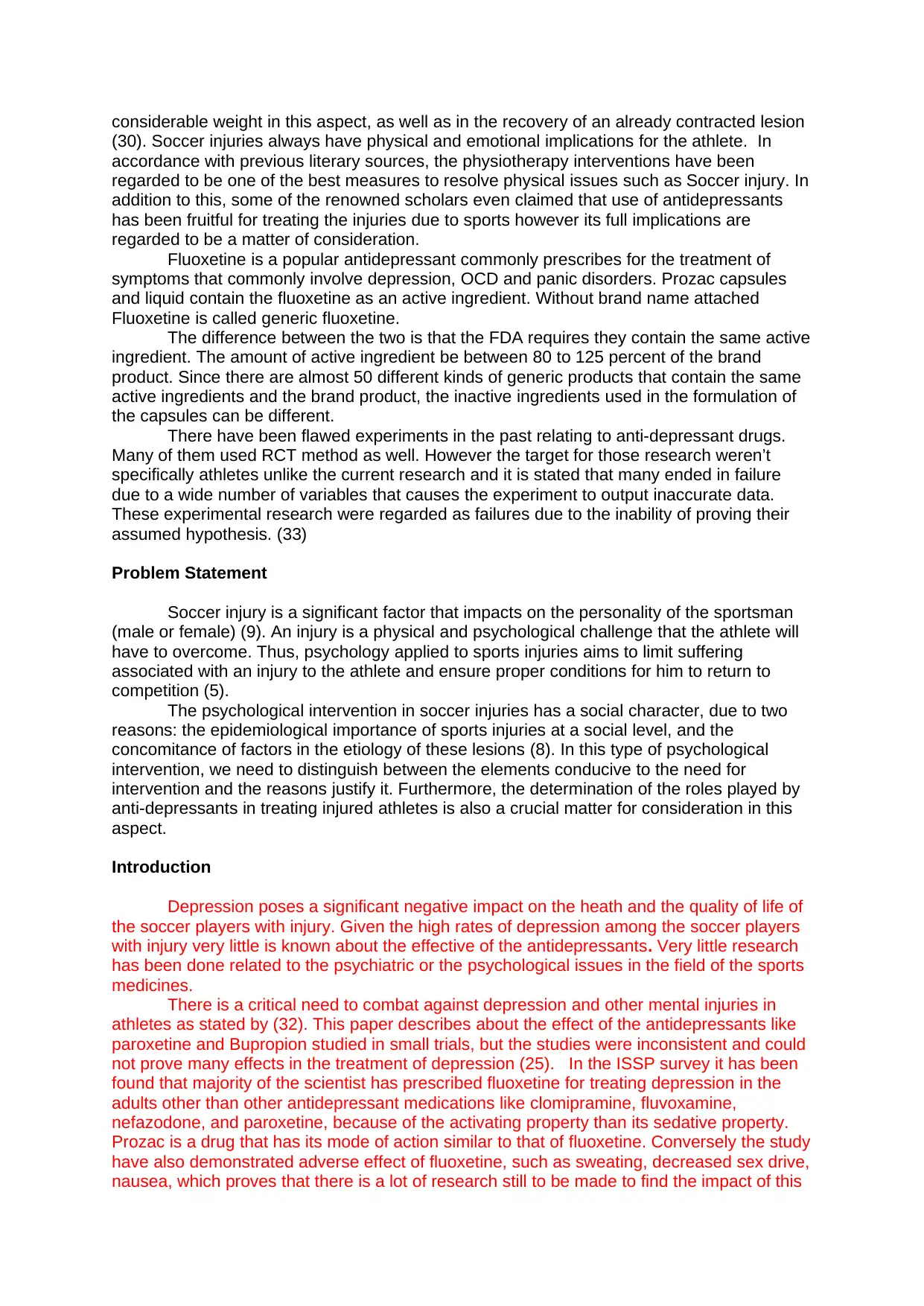
considerable weight in this aspect, as well as in the recovery of an already contracted lesion
(30). Soccer injuries always have physical and emotional implications for the athlete. In
accordance with previous literary sources, the physiotherapy interventions have been
regarded to be one of the best measures to resolve physical issues such as Soccer injury. In
addition to this, some of the renowned scholars even claimed that use of antidepressants
has been fruitful for treating the injuries due to sports however its full implications are
regarded to be a matter of consideration.
Fluoxetine is a popular antidepressant commonly prescribes for the treatment of
symptoms that commonly involve depression, OCD and panic disorders. Prozac capsules
and liquid contain the fluoxetine as an active ingredient. Without brand name attached
Fluoxetine is called generic fluoxetine.
The difference between the two is that the FDA requires they contain the same active
ingredient. The amount of active ingredient be between 80 to 125 percent of the brand
product. Since there are almost 50 different kinds of generic products that contain the same
active ingredients and the brand product, the inactive ingredients used in the formulation of
the capsules can be different.
There have been flawed experiments in the past relating to anti-depressant drugs.
Many of them used RCT method as well. However the target for those research weren’t
specifically athletes unlike the current research and it is stated that many ended in failure
due to a wide number of variables that causes the experiment to output inaccurate data.
These experimental research were regarded as failures due to the inability of proving their
assumed hypothesis. (33)
Problem Statement
Soccer injury is a significant factor that impacts on the personality of the sportsman
(male or female) (9). An injury is a physical and psychological challenge that the athlete will
have to overcome. Thus, psychology applied to sports injuries aims to limit suffering
associated with an injury to the athlete and ensure proper conditions for him to return to
competition (5).
The psychological intervention in soccer injuries has a social character, due to two
reasons: the epidemiological importance of sports injuries at a social level, and the
concomitance of factors in the etiology of these lesions (8). In this type of psychological
intervention, we need to distinguish between the elements conducive to the need for
intervention and the reasons justify it. Furthermore, the determination of the roles played by
anti-depressants in treating injured athletes is also a crucial matter for consideration in this
aspect.
Introduction
Depression poses a significant negative impact on the heath and the quality of life of
the soccer players with injury. Given the high rates of depression among the soccer players
with injury very little is known about the effective of the antidepressants. Very little research
has been done related to the psychiatric or the psychological issues in the field of the sports
medicines.
There is a critical need to combat against depression and other mental injuries in
athletes as stated by (32). This paper describes about the effect of the antidepressants like
paroxetine and Bupropion studied in small trials, but the studies were inconsistent and could
not prove many effects in the treatment of depression (25). In the ISSP survey it has been
found that majority of the scientist has prescribed fluoxetine for treating depression in the
adults other than other antidepressant medications like clomipramine, fluvoxamine,
nefazodone, and paroxetine, because of the activating property than its sedative property.
Prozac is a drug that has its mode of action similar to that of fluoxetine. Conversely the study
have also demonstrated adverse effect of fluoxetine, such as sweating, decreased sex drive,
nausea, which proves that there is a lot of research still to be made to find the impact of this
(30). Soccer injuries always have physical and emotional implications for the athlete. In
accordance with previous literary sources, the physiotherapy interventions have been
regarded to be one of the best measures to resolve physical issues such as Soccer injury. In
addition to this, some of the renowned scholars even claimed that use of antidepressants
has been fruitful for treating the injuries due to sports however its full implications are
regarded to be a matter of consideration.
Fluoxetine is a popular antidepressant commonly prescribes for the treatment of
symptoms that commonly involve depression, OCD and panic disorders. Prozac capsules
and liquid contain the fluoxetine as an active ingredient. Without brand name attached
Fluoxetine is called generic fluoxetine.
The difference between the two is that the FDA requires they contain the same active
ingredient. The amount of active ingredient be between 80 to 125 percent of the brand
product. Since there are almost 50 different kinds of generic products that contain the same
active ingredients and the brand product, the inactive ingredients used in the formulation of
the capsules can be different.
There have been flawed experiments in the past relating to anti-depressant drugs.
Many of them used RCT method as well. However the target for those research weren’t
specifically athletes unlike the current research and it is stated that many ended in failure
due to a wide number of variables that causes the experiment to output inaccurate data.
These experimental research were regarded as failures due to the inability of proving their
assumed hypothesis. (33)
Problem Statement
Soccer injury is a significant factor that impacts on the personality of the sportsman
(male or female) (9). An injury is a physical and psychological challenge that the athlete will
have to overcome. Thus, psychology applied to sports injuries aims to limit suffering
associated with an injury to the athlete and ensure proper conditions for him to return to
competition (5).
The psychological intervention in soccer injuries has a social character, due to two
reasons: the epidemiological importance of sports injuries at a social level, and the
concomitance of factors in the etiology of these lesions (8). In this type of psychological
intervention, we need to distinguish between the elements conducive to the need for
intervention and the reasons justify it. Furthermore, the determination of the roles played by
anti-depressants in treating injured athletes is also a crucial matter for consideration in this
aspect.
Introduction
Depression poses a significant negative impact on the heath and the quality of life of
the soccer players with injury. Given the high rates of depression among the soccer players
with injury very little is known about the effective of the antidepressants. Very little research
has been done related to the psychiatric or the psychological issues in the field of the sports
medicines.
There is a critical need to combat against depression and other mental injuries in
athletes as stated by (32). This paper describes about the effect of the antidepressants like
paroxetine and Bupropion studied in small trials, but the studies were inconsistent and could
not prove many effects in the treatment of depression (25). In the ISSP survey it has been
found that majority of the scientist has prescribed fluoxetine for treating depression in the
adults other than other antidepressant medications like clomipramine, fluvoxamine,
nefazodone, and paroxetine, because of the activating property than its sedative property.
Prozac is a drug that has its mode of action similar to that of fluoxetine. Conversely the study
have also demonstrated adverse effect of fluoxetine, such as sweating, decreased sex drive,
nausea, which proves that there is a lot of research still to be made to find the impact of this
⊘ This is a preview!⊘
Do you want full access?
Subscribe today to unlock all pages.

Trusted by 1+ million students worldwide
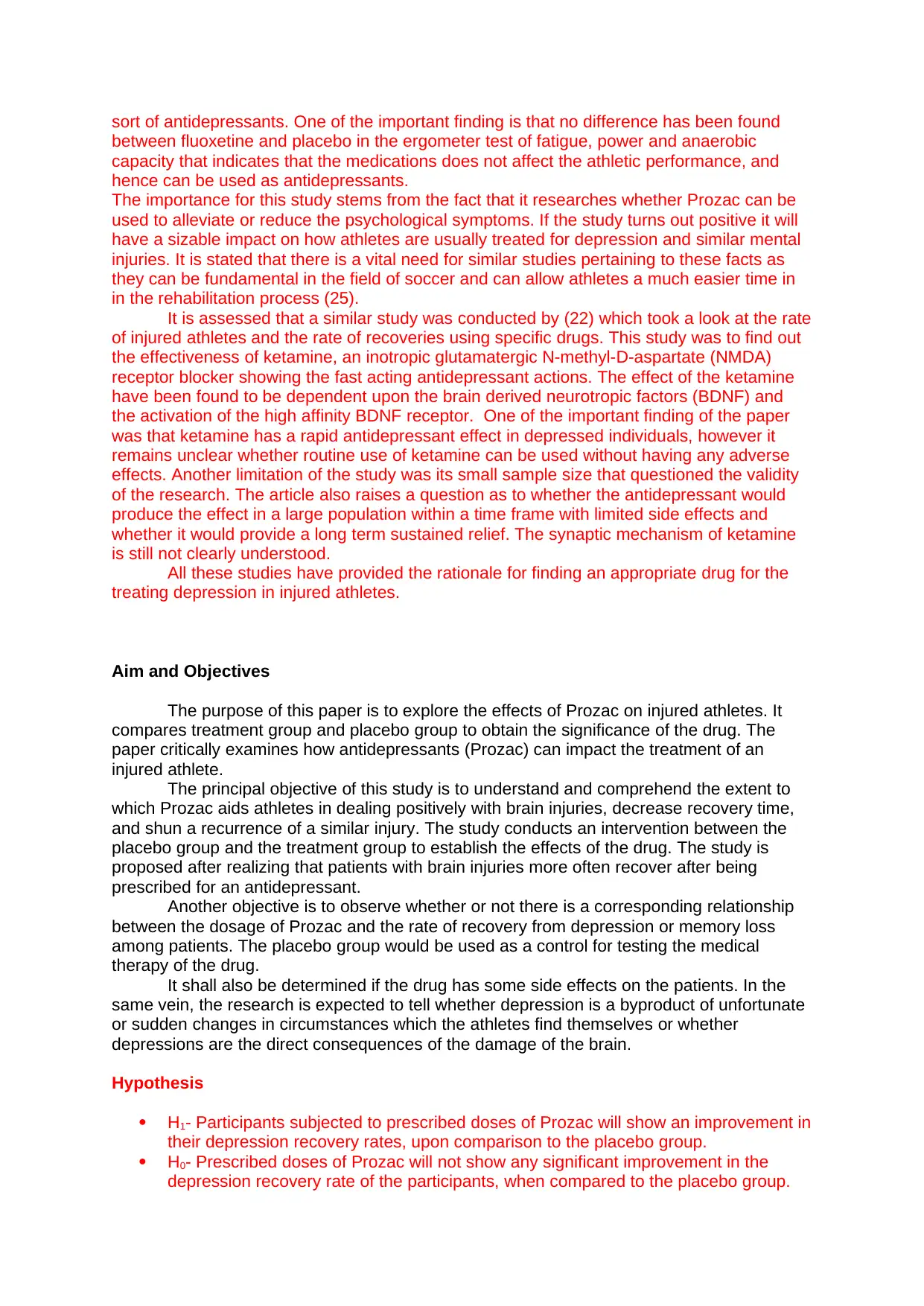
sort of antidepressants. One of the important finding is that no difference has been found
between fluoxetine and placebo in the ergometer test of fatigue, power and anaerobic
capacity that indicates that the medications does not affect the athletic performance, and
hence can be used as antidepressants.
The importance for this study stems from the fact that it researches whether Prozac can be
used to alleviate or reduce the psychological symptoms. If the study turns out positive it will
have a sizable impact on how athletes are usually treated for depression and similar mental
injuries. It is stated that there is a vital need for similar studies pertaining to these facts as
they can be fundamental in the field of soccer and can allow athletes a much easier time in
in the rehabilitation process (25).
It is assessed that a similar study was conducted by (22) which took a look at the rate
of injured athletes and the rate of recoveries using specific drugs. This study was to find out
the effectiveness of ketamine, an inotropic glutamatergic N-methyl-D-aspartate (NMDA)
receptor blocker showing the fast acting antidepressant actions. The effect of the ketamine
have been found to be dependent upon the brain derived neurotropic factors (BDNF) and
the activation of the high affinity BDNF receptor. One of the important finding of the paper
was that ketamine has a rapid antidepressant effect in depressed individuals, however it
remains unclear whether routine use of ketamine can be used without having any adverse
effects. Another limitation of the study was its small sample size that questioned the validity
of the research. The article also raises a question as to whether the antidepressant would
produce the effect in a large population within a time frame with limited side effects and
whether it would provide a long term sustained relief. The synaptic mechanism of ketamine
is still not clearly understood.
All these studies have provided the rationale for finding an appropriate drug for the
treating depression in injured athletes.
Aim and Objectives
The purpose of this paper is to explore the effects of Prozac on injured athletes. It
compares treatment group and placebo group to obtain the significance of the drug. The
paper critically examines how antidepressants (Prozac) can impact the treatment of an
injured athlete.
The principal objective of this study is to understand and comprehend the extent to
which Prozac aids athletes in dealing positively with brain injuries, decrease recovery time,
and shun a recurrence of a similar injury. The study conducts an intervention between the
placebo group and the treatment group to establish the effects of the drug. The study is
proposed after realizing that patients with brain injuries more often recover after being
prescribed for an antidepressant.
Another objective is to observe whether or not there is a corresponding relationship
between the dosage of Prozac and the rate of recovery from depression or memory loss
among patients. The placebo group would be used as a control for testing the medical
therapy of the drug.
It shall also be determined if the drug has some side effects on the patients. In the
same vein, the research is expected to tell whether depression is a byproduct of unfortunate
or sudden changes in circumstances which the athletes find themselves or whether
depressions are the direct consequences of the damage of the brain.
Hypothesis
H1- Participants subjected to prescribed doses of Prozac will show an improvement in
their depression recovery rates, upon comparison to the placebo group.
H0- Prescribed doses of Prozac will not show any significant improvement in the
depression recovery rate of the participants, when compared to the placebo group.
between fluoxetine and placebo in the ergometer test of fatigue, power and anaerobic
capacity that indicates that the medications does not affect the athletic performance, and
hence can be used as antidepressants.
The importance for this study stems from the fact that it researches whether Prozac can be
used to alleviate or reduce the psychological symptoms. If the study turns out positive it will
have a sizable impact on how athletes are usually treated for depression and similar mental
injuries. It is stated that there is a vital need for similar studies pertaining to these facts as
they can be fundamental in the field of soccer and can allow athletes a much easier time in
in the rehabilitation process (25).
It is assessed that a similar study was conducted by (22) which took a look at the rate
of injured athletes and the rate of recoveries using specific drugs. This study was to find out
the effectiveness of ketamine, an inotropic glutamatergic N-methyl-D-aspartate (NMDA)
receptor blocker showing the fast acting antidepressant actions. The effect of the ketamine
have been found to be dependent upon the brain derived neurotropic factors (BDNF) and
the activation of the high affinity BDNF receptor. One of the important finding of the paper
was that ketamine has a rapid antidepressant effect in depressed individuals, however it
remains unclear whether routine use of ketamine can be used without having any adverse
effects. Another limitation of the study was its small sample size that questioned the validity
of the research. The article also raises a question as to whether the antidepressant would
produce the effect in a large population within a time frame with limited side effects and
whether it would provide a long term sustained relief. The synaptic mechanism of ketamine
is still not clearly understood.
All these studies have provided the rationale for finding an appropriate drug for the
treating depression in injured athletes.
Aim and Objectives
The purpose of this paper is to explore the effects of Prozac on injured athletes. It
compares treatment group and placebo group to obtain the significance of the drug. The
paper critically examines how antidepressants (Prozac) can impact the treatment of an
injured athlete.
The principal objective of this study is to understand and comprehend the extent to
which Prozac aids athletes in dealing positively with brain injuries, decrease recovery time,
and shun a recurrence of a similar injury. The study conducts an intervention between the
placebo group and the treatment group to establish the effects of the drug. The study is
proposed after realizing that patients with brain injuries more often recover after being
prescribed for an antidepressant.
Another objective is to observe whether or not there is a corresponding relationship
between the dosage of Prozac and the rate of recovery from depression or memory loss
among patients. The placebo group would be used as a control for testing the medical
therapy of the drug.
It shall also be determined if the drug has some side effects on the patients. In the
same vein, the research is expected to tell whether depression is a byproduct of unfortunate
or sudden changes in circumstances which the athletes find themselves or whether
depressions are the direct consequences of the damage of the brain.
Hypothesis
H1- Participants subjected to prescribed doses of Prozac will show an improvement in
their depression recovery rates, upon comparison to the placebo group.
H0- Prescribed doses of Prozac will not show any significant improvement in the
depression recovery rate of the participants, when compared to the placebo group.
Paraphrase This Document
Need a fresh take? Get an instant paraphrase of this document with our AI Paraphraser
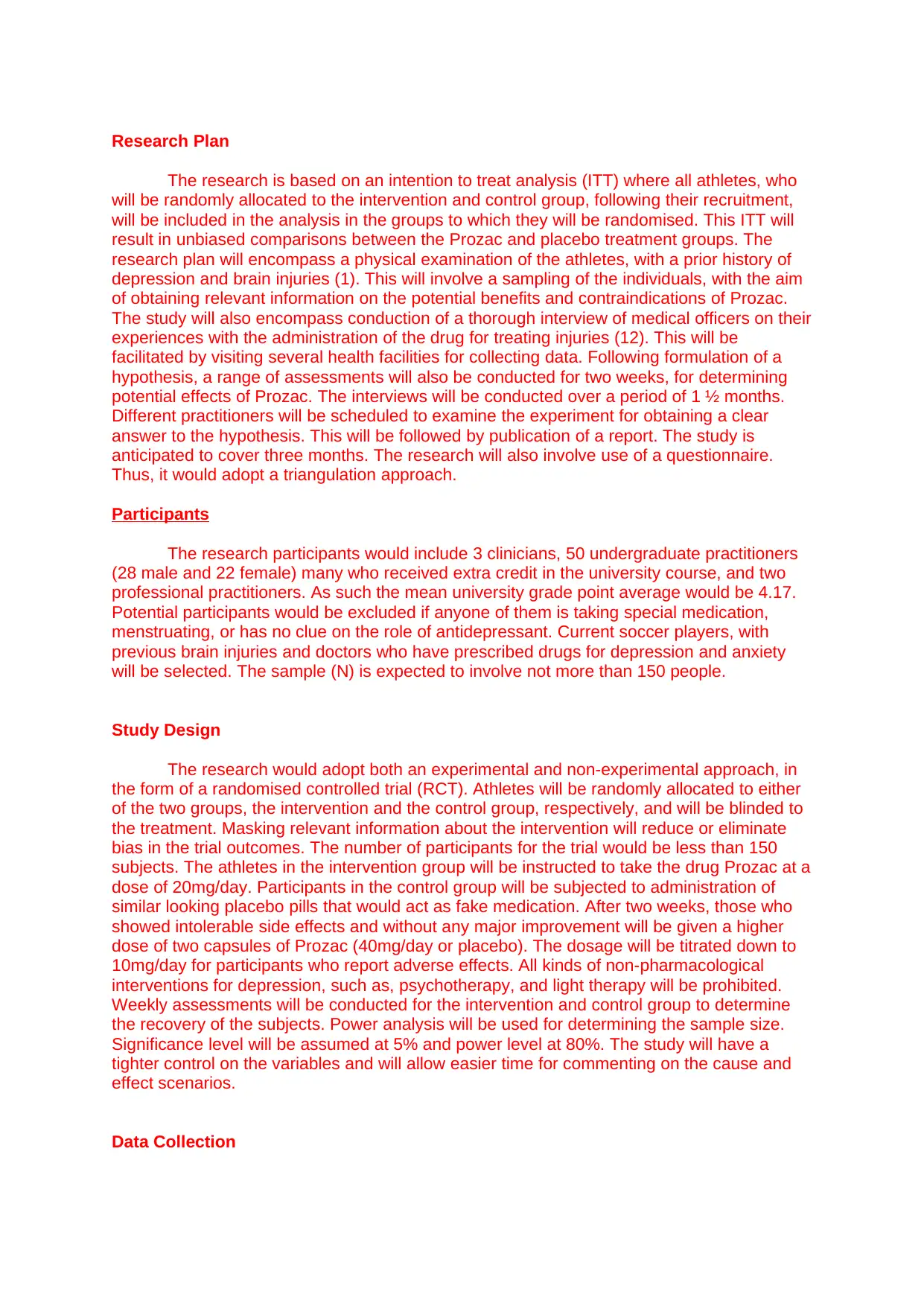
Research Plan
The research is based on an intention to treat analysis (ITT) where all athletes, who
will be randomly allocated to the intervention and control group, following their recruitment,
will be included in the analysis in the groups to which they will be randomised. This ITT will
result in unbiased comparisons between the Prozac and placebo treatment groups. The
research plan will encompass a physical examination of the athletes, with a prior history of
depression and brain injuries (1). This will involve a sampling of the individuals, with the aim
of obtaining relevant information on the potential benefits and contraindications of Prozac.
The study will also encompass conduction of a thorough interview of medical officers on their
experiences with the administration of the drug for treating injuries (12). This will be
facilitated by visiting several health facilities for collecting data. Following formulation of a
hypothesis, a range of assessments will also be conducted for two weeks, for determining
potential effects of Prozac. The interviews will be conducted over a period of 1 ½ months.
Different practitioners will be scheduled to examine the experiment for obtaining a clear
answer to the hypothesis. This will be followed by publication of a report. The study is
anticipated to cover three months. The research will also involve use of a questionnaire.
Thus, it would adopt a triangulation approach.
Participants
The research participants would include 3 clinicians, 50 undergraduate practitioners
(28 male and 22 female) many who received extra credit in the university course, and two
professional practitioners. As such the mean university grade point average would be 4.17.
Potential participants would be excluded if anyone of them is taking special medication,
menstruating, or has no clue on the role of antidepressant. Current soccer players, with
previous brain injuries and doctors who have prescribed drugs for depression and anxiety
will be selected. The sample (N) is expected to involve not more than 150 people.
Study Design
The research would adopt both an experimental and non-experimental approach, in
the form of a randomised controlled trial (RCT). Athletes will be randomly allocated to either
of the two groups, the intervention and the control group, respectively, and will be blinded to
the treatment. Masking relevant information about the intervention will reduce or eliminate
bias in the trial outcomes. The number of participants for the trial would be less than 150
subjects. The athletes in the intervention group will be instructed to take the drug Prozac at a
dose of 20mg/day. Participants in the control group will be subjected to administration of
similar looking placebo pills that would act as fake medication. After two weeks, those who
showed intolerable side effects and without any major improvement will be given a higher
dose of two capsules of Prozac (40mg/day or placebo). The dosage will be titrated down to
10mg/day for participants who report adverse effects. All kinds of non-pharmacological
interventions for depression, such as, psychotherapy, and light therapy will be prohibited.
Weekly assessments will be conducted for the intervention and control group to determine
the recovery of the subjects. Power analysis will be used for determining the sample size.
Significance level will be assumed at 5% and power level at 80%. The study will have a
tighter control on the variables and will allow easier time for commenting on the cause and
effect scenarios.
Data Collection
The research is based on an intention to treat analysis (ITT) where all athletes, who
will be randomly allocated to the intervention and control group, following their recruitment,
will be included in the analysis in the groups to which they will be randomised. This ITT will
result in unbiased comparisons between the Prozac and placebo treatment groups. The
research plan will encompass a physical examination of the athletes, with a prior history of
depression and brain injuries (1). This will involve a sampling of the individuals, with the aim
of obtaining relevant information on the potential benefits and contraindications of Prozac.
The study will also encompass conduction of a thorough interview of medical officers on their
experiences with the administration of the drug for treating injuries (12). This will be
facilitated by visiting several health facilities for collecting data. Following formulation of a
hypothesis, a range of assessments will also be conducted for two weeks, for determining
potential effects of Prozac. The interviews will be conducted over a period of 1 ½ months.
Different practitioners will be scheduled to examine the experiment for obtaining a clear
answer to the hypothesis. This will be followed by publication of a report. The study is
anticipated to cover three months. The research will also involve use of a questionnaire.
Thus, it would adopt a triangulation approach.
Participants
The research participants would include 3 clinicians, 50 undergraduate practitioners
(28 male and 22 female) many who received extra credit in the university course, and two
professional practitioners. As such the mean university grade point average would be 4.17.
Potential participants would be excluded if anyone of them is taking special medication,
menstruating, or has no clue on the role of antidepressant. Current soccer players, with
previous brain injuries and doctors who have prescribed drugs for depression and anxiety
will be selected. The sample (N) is expected to involve not more than 150 people.
Study Design
The research would adopt both an experimental and non-experimental approach, in
the form of a randomised controlled trial (RCT). Athletes will be randomly allocated to either
of the two groups, the intervention and the control group, respectively, and will be blinded to
the treatment. Masking relevant information about the intervention will reduce or eliminate
bias in the trial outcomes. The number of participants for the trial would be less than 150
subjects. The athletes in the intervention group will be instructed to take the drug Prozac at a
dose of 20mg/day. Participants in the control group will be subjected to administration of
similar looking placebo pills that would act as fake medication. After two weeks, those who
showed intolerable side effects and without any major improvement will be given a higher
dose of two capsules of Prozac (40mg/day or placebo). The dosage will be titrated down to
10mg/day for participants who report adverse effects. All kinds of non-pharmacological
interventions for depression, such as, psychotherapy, and light therapy will be prohibited.
Weekly assessments will be conducted for the intervention and control group to determine
the recovery of the subjects. Power analysis will be used for determining the sample size.
Significance level will be assumed at 5% and power level at 80%. The study will have a
tighter control on the variables and will allow easier time for commenting on the cause and
effect scenarios.
Data Collection
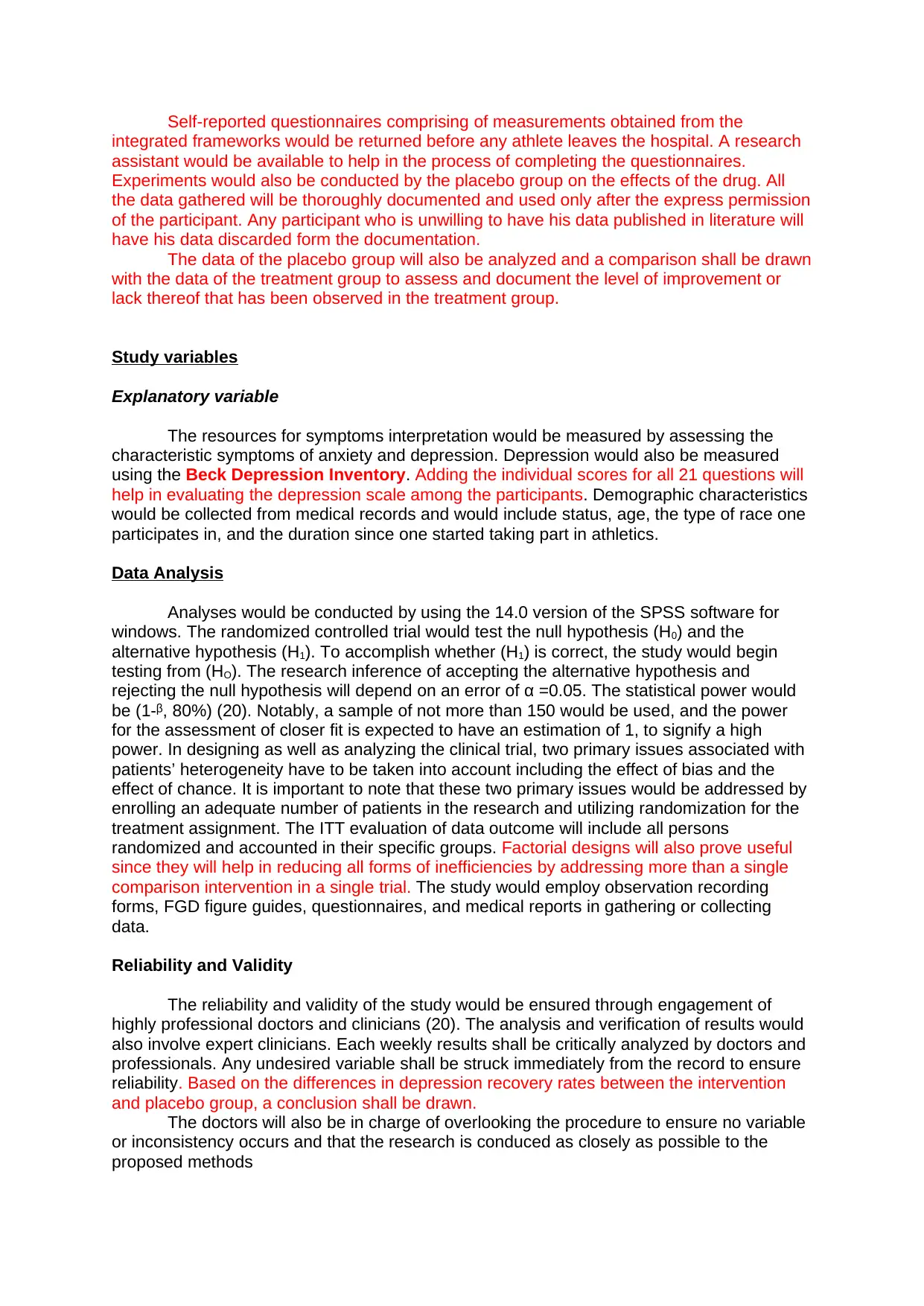
Self-reported questionnaires comprising of measurements obtained from the
integrated frameworks would be returned before any athlete leaves the hospital. A research
assistant would be available to help in the process of completing the questionnaires.
Experiments would also be conducted by the placebo group on the effects of the drug. All
the data gathered will be thoroughly documented and used only after the express permission
of the participant. Any participant who is unwilling to have his data published in literature will
have his data discarded form the documentation.
The data of the placebo group will also be analyzed and a comparison shall be drawn
with the data of the treatment group to assess and document the level of improvement or
lack thereof that has been observed in the treatment group.
Study variables
Explanatory variable
The resources for symptoms interpretation would be measured by assessing the
characteristic symptoms of anxiety and depression. Depression would also be measured
using the Beck Depression Inventory. Adding the individual scores for all 21 questions will
help in evaluating the depression scale among the participants. Demographic characteristics
would be collected from medical records and would include status, age, the type of race one
participates in, and the duration since one started taking part in athletics.
Data Analysis
Analyses would be conducted by using the 14.0 version of the SPSS software for
windows. The randomized controlled trial would test the null hypothesis (H0) and the
alternative hypothesis (H1). To accomplish whether (H1) is correct, the study would begin
testing from (HO). The research inference of accepting the alternative hypothesis and
rejecting the null hypothesis will depend on an error of α =0.05. The statistical power would
be (1-ᵝ, 80%) (20). Notably, a sample of not more than 150 would be used, and the power
for the assessment of closer fit is expected to have an estimation of 1, to signify a high
power. In designing as well as analyzing the clinical trial, two primary issues associated with
patients’ heterogeneity have to be taken into account including the effect of bias and the
effect of chance. It is important to note that these two primary issues would be addressed by
enrolling an adequate number of patients in the research and utilizing randomization for the
treatment assignment. The ITT evaluation of data outcome will include all persons
randomized and accounted in their specific groups. Factorial designs will also prove useful
since they will help in reducing all forms of inefficiencies by addressing more than a single
comparison intervention in a single trial. The study would employ observation recording
forms, FGD figure guides, questionnaires, and medical reports in gathering or collecting
data.
Reliability and Validity
The reliability and validity of the study would be ensured through engagement of
highly professional doctors and clinicians (20). The analysis and verification of results would
also involve expert clinicians. Each weekly results shall be critically analyzed by doctors and
professionals. Any undesired variable shall be struck immediately from the record to ensure
reliability. Based on the differences in depression recovery rates between the intervention
and placebo group, a conclusion shall be drawn.
The doctors will also be in charge of overlooking the procedure to ensure no variable
or inconsistency occurs and that the research is conduced as closely as possible to the
proposed methods
integrated frameworks would be returned before any athlete leaves the hospital. A research
assistant would be available to help in the process of completing the questionnaires.
Experiments would also be conducted by the placebo group on the effects of the drug. All
the data gathered will be thoroughly documented and used only after the express permission
of the participant. Any participant who is unwilling to have his data published in literature will
have his data discarded form the documentation.
The data of the placebo group will also be analyzed and a comparison shall be drawn
with the data of the treatment group to assess and document the level of improvement or
lack thereof that has been observed in the treatment group.
Study variables
Explanatory variable
The resources for symptoms interpretation would be measured by assessing the
characteristic symptoms of anxiety and depression. Depression would also be measured
using the Beck Depression Inventory. Adding the individual scores for all 21 questions will
help in evaluating the depression scale among the participants. Demographic characteristics
would be collected from medical records and would include status, age, the type of race one
participates in, and the duration since one started taking part in athletics.
Data Analysis
Analyses would be conducted by using the 14.0 version of the SPSS software for
windows. The randomized controlled trial would test the null hypothesis (H0) and the
alternative hypothesis (H1). To accomplish whether (H1) is correct, the study would begin
testing from (HO). The research inference of accepting the alternative hypothesis and
rejecting the null hypothesis will depend on an error of α =0.05. The statistical power would
be (1-ᵝ, 80%) (20). Notably, a sample of not more than 150 would be used, and the power
for the assessment of closer fit is expected to have an estimation of 1, to signify a high
power. In designing as well as analyzing the clinical trial, two primary issues associated with
patients’ heterogeneity have to be taken into account including the effect of bias and the
effect of chance. It is important to note that these two primary issues would be addressed by
enrolling an adequate number of patients in the research and utilizing randomization for the
treatment assignment. The ITT evaluation of data outcome will include all persons
randomized and accounted in their specific groups. Factorial designs will also prove useful
since they will help in reducing all forms of inefficiencies by addressing more than a single
comparison intervention in a single trial. The study would employ observation recording
forms, FGD figure guides, questionnaires, and medical reports in gathering or collecting
data.
Reliability and Validity
The reliability and validity of the study would be ensured through engagement of
highly professional doctors and clinicians (20). The analysis and verification of results would
also involve expert clinicians. Each weekly results shall be critically analyzed by doctors and
professionals. Any undesired variable shall be struck immediately from the record to ensure
reliability. Based on the differences in depression recovery rates between the intervention
and placebo group, a conclusion shall be drawn.
The doctors will also be in charge of overlooking the procedure to ensure no variable
or inconsistency occurs and that the research is conduced as closely as possible to the
proposed methods
⊘ This is a preview!⊘
Do you want full access?
Subscribe today to unlock all pages.

Trusted by 1+ million students worldwide
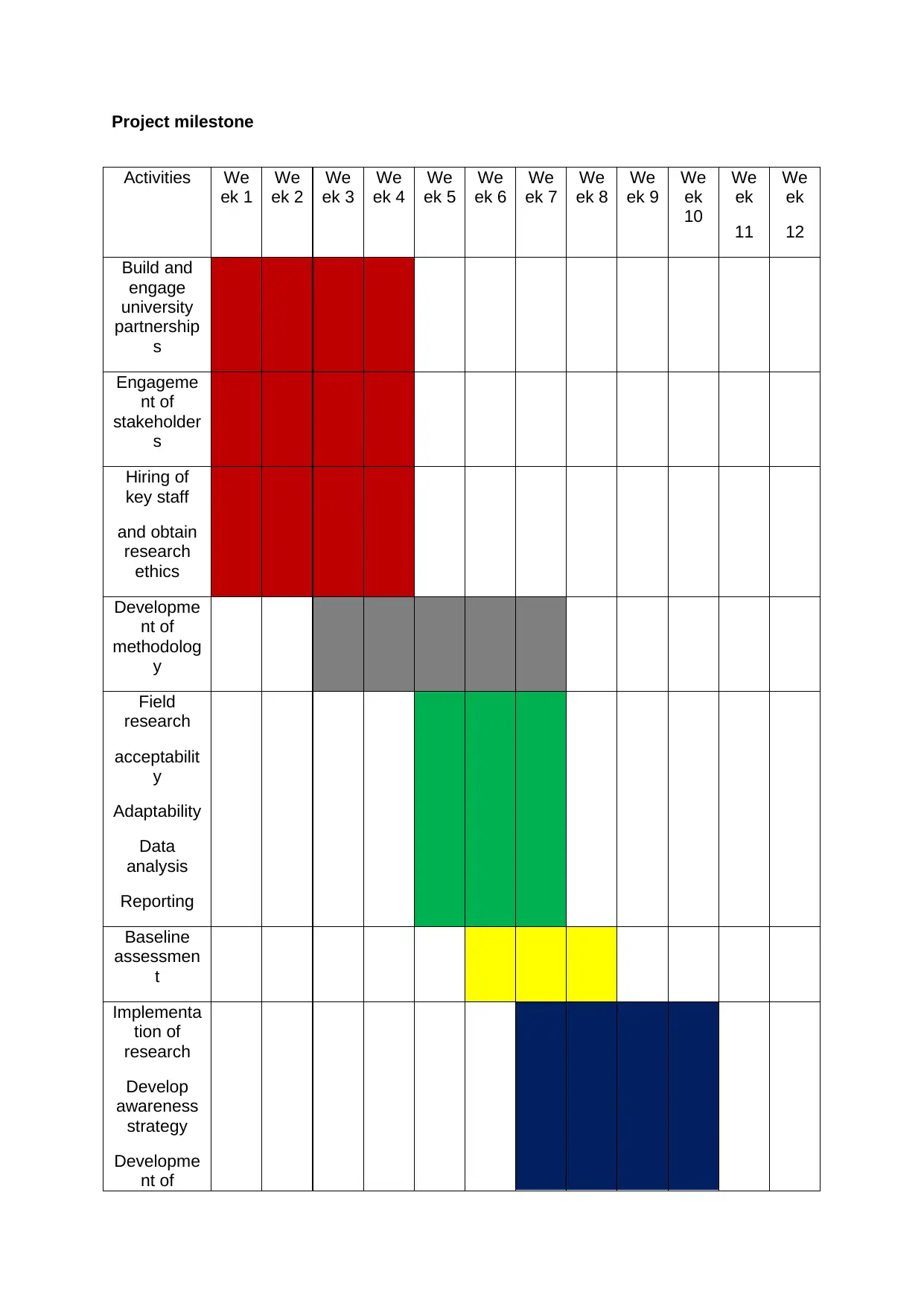
Project milestone
Activities We
ek 1
We
ek 2
We
ek 3
We
ek 4
We
ek 5
We
ek 6
We
ek 7
We
ek 8
We
ek 9
We
ek
10
We
ek
11
We
ek
12
Build and
engage
university
partnership
s
Engageme
nt of
stakeholder
s
Hiring of
key staff
and obtain
research
ethics
Developme
nt of
methodolog
y
Field
research
acceptabilit
y
Adaptability
Data
analysis
Reporting
Baseline
assessmen
t
Implementa
tion of
research
Develop
awareness
strategy
Developme
nt of
Activities We
ek 1
We
ek 2
We
ek 3
We
ek 4
We
ek 5
We
ek 6
We
ek 7
We
ek 8
We
ek 9
We
ek
10
We
ek
11
We
ek
12
Build and
engage
university
partnership
s
Engageme
nt of
stakeholder
s
Hiring of
key staff
and obtain
research
ethics
Developme
nt of
methodolog
y
Field
research
acceptabilit
y
Adaptability
Data
analysis
Reporting
Baseline
assessmen
t
Implementa
tion of
research
Develop
awareness
strategy
Developme
nt of
Paraphrase This Document
Need a fresh take? Get an instant paraphrase of this document with our AI Paraphraser
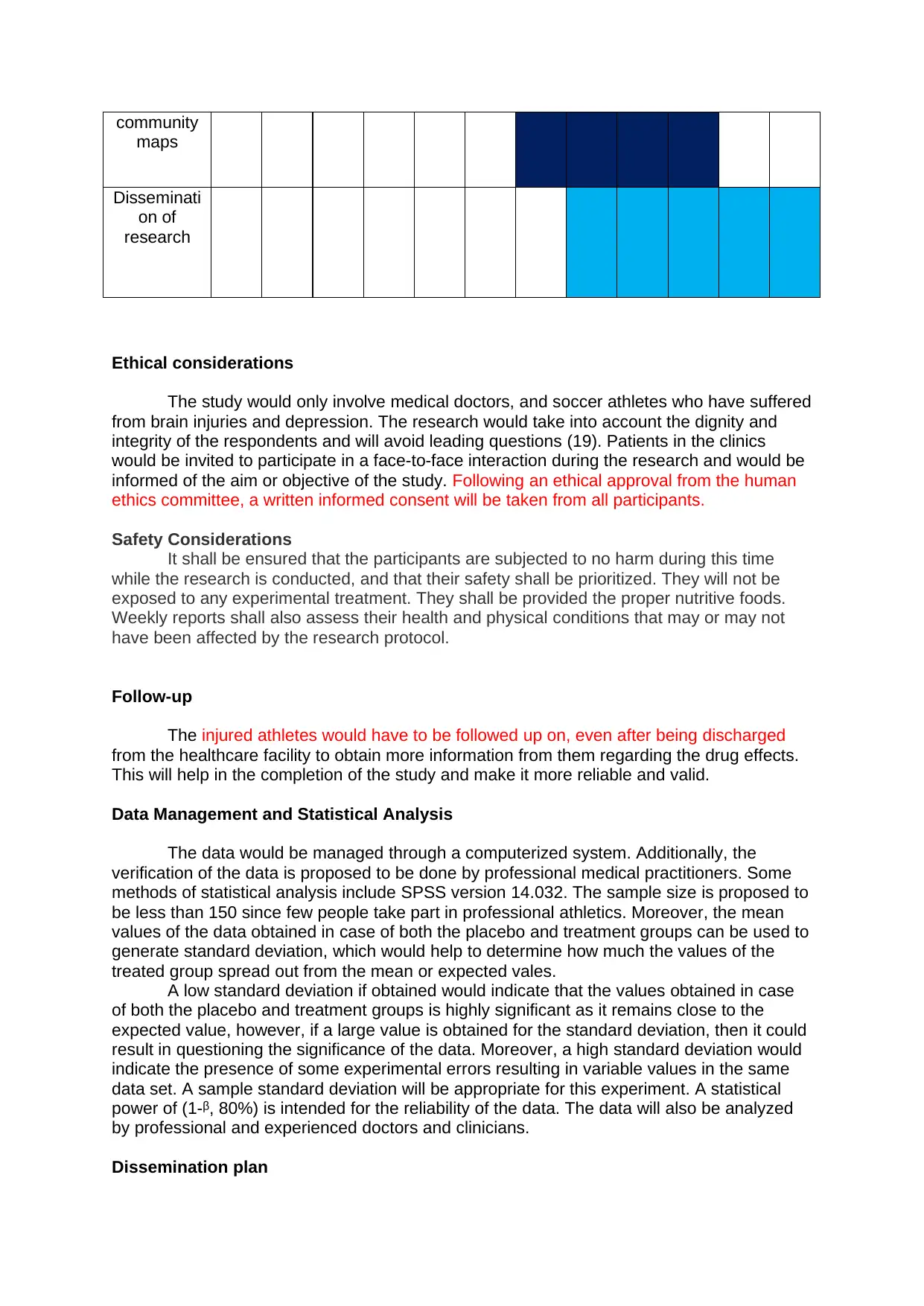
community
maps
Disseminati
on of
research
Ethical considerations
The study would only involve medical doctors, and soccer athletes who have suffered
from brain injuries and depression. The research would take into account the dignity and
integrity of the respondents and will avoid leading questions (19). Patients in the clinics
would be invited to participate in a face-to-face interaction during the research and would be
informed of the aim or objective of the study. Following an ethical approval from the human
ethics committee, a written informed consent will be taken from all participants.
Safety Considerations
It shall be ensured that the participants are subjected to no harm during this time
while the research is conducted, and that their safety shall be prioritized. They will not be
exposed to any experimental treatment. They shall be provided the proper nutritive foods.
Weekly reports shall also assess their health and physical conditions that may or may not
have been affected by the research protocol.
Follow-up
The injured athletes would have to be followed up on, even after being discharged
from the healthcare facility to obtain more information from them regarding the drug effects.
This will help in the completion of the study and make it more reliable and valid.
Data Management and Statistical Analysis
The data would be managed through a computerized system. Additionally, the
verification of the data is proposed to be done by professional medical practitioners. Some
methods of statistical analysis include SPSS version 14.032. The sample size is proposed to
be less than 150 since few people take part in professional athletics. Moreover, the mean
values of the data obtained in case of both the placebo and treatment groups can be used to
generate standard deviation, which would help to determine how much the values of the
treated group spread out from the mean or expected vales.
A low standard deviation if obtained would indicate that the values obtained in case
of both the placebo and treatment groups is highly significant as it remains close to the
expected value, however, if a large value is obtained for the standard deviation, then it could
result in questioning the significance of the data. Moreover, a high standard deviation would
indicate the presence of some experimental errors resulting in variable values in the same
data set. A sample standard deviation will be appropriate for this experiment. A statistical
power of (1-ᵝ, 80%) is intended for the reliability of the data. The data will also be analyzed
by professional and experienced doctors and clinicians.
Dissemination plan
maps
Disseminati
on of
research
Ethical considerations
The study would only involve medical doctors, and soccer athletes who have suffered
from brain injuries and depression. The research would take into account the dignity and
integrity of the respondents and will avoid leading questions (19). Patients in the clinics
would be invited to participate in a face-to-face interaction during the research and would be
informed of the aim or objective of the study. Following an ethical approval from the human
ethics committee, a written informed consent will be taken from all participants.
Safety Considerations
It shall be ensured that the participants are subjected to no harm during this time
while the research is conducted, and that their safety shall be prioritized. They will not be
exposed to any experimental treatment. They shall be provided the proper nutritive foods.
Weekly reports shall also assess their health and physical conditions that may or may not
have been affected by the research protocol.
Follow-up
The injured athletes would have to be followed up on, even after being discharged
from the healthcare facility to obtain more information from them regarding the drug effects.
This will help in the completion of the study and make it more reliable and valid.
Data Management and Statistical Analysis
The data would be managed through a computerized system. Additionally, the
verification of the data is proposed to be done by professional medical practitioners. Some
methods of statistical analysis include SPSS version 14.032. The sample size is proposed to
be less than 150 since few people take part in professional athletics. Moreover, the mean
values of the data obtained in case of both the placebo and treatment groups can be used to
generate standard deviation, which would help to determine how much the values of the
treated group spread out from the mean or expected vales.
A low standard deviation if obtained would indicate that the values obtained in case
of both the placebo and treatment groups is highly significant as it remains close to the
expected value, however, if a large value is obtained for the standard deviation, then it could
result in questioning the significance of the data. Moreover, a high standard deviation would
indicate the presence of some experimental errors resulting in variable values in the same
data set. A sample standard deviation will be appropriate for this experiment. A statistical
power of (1-ᵝ, 80%) is intended for the reliability of the data. The data will also be analyzed
by professional and experienced doctors and clinicians.
Dissemination plan
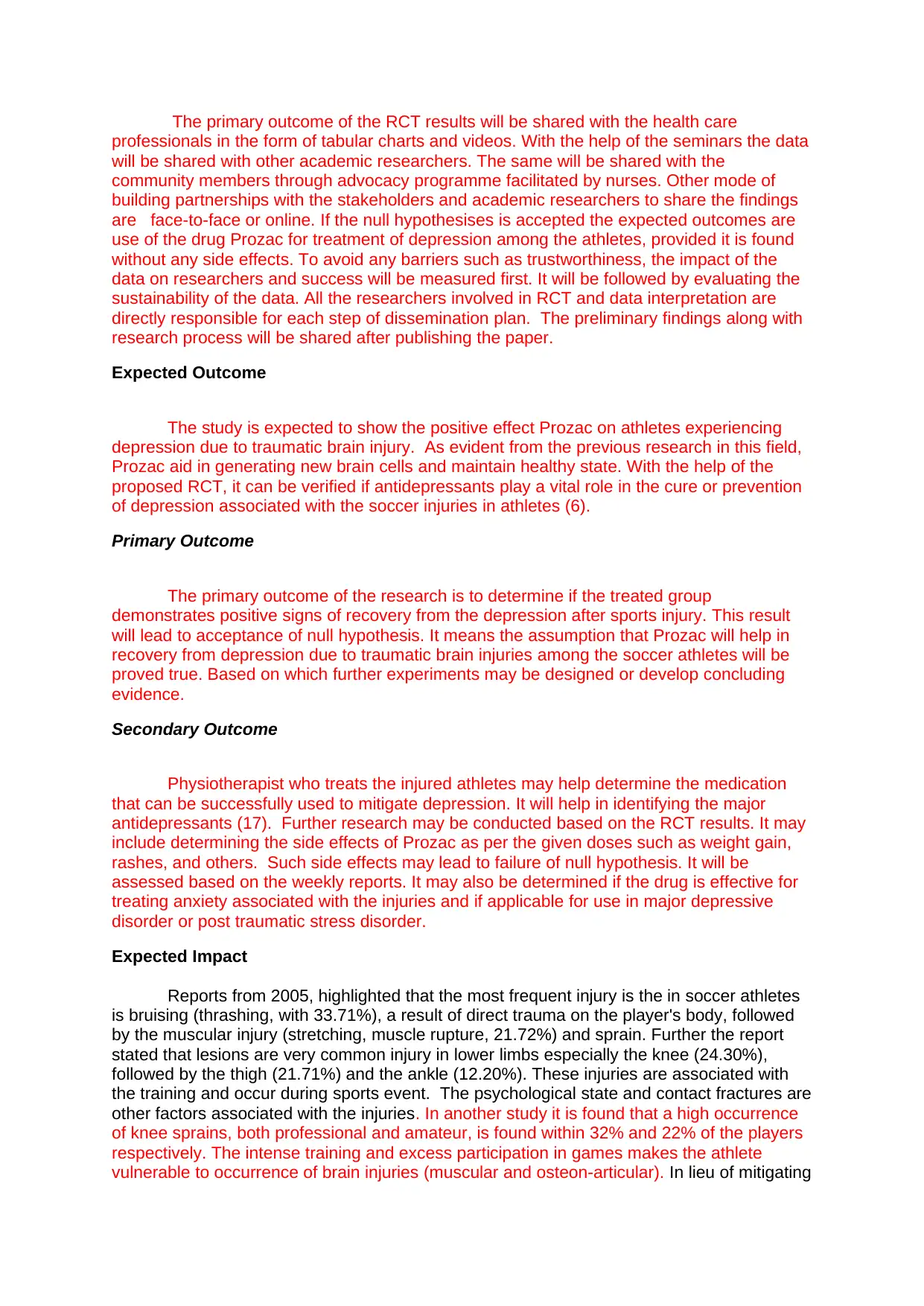
The primary outcome of the RCT results will be shared with the health care
professionals in the form of tabular charts and videos. With the help of the seminars the data
will be shared with other academic researchers. The same will be shared with the
community members through advocacy programme facilitated by nurses. Other mode of
building partnerships with the stakeholders and academic researchers to share the findings
are face-to-face or online. If the null hypothesises is accepted the expected outcomes are
use of the drug Prozac for treatment of depression among the athletes, provided it is found
without any side effects. To avoid any barriers such as trustworthiness, the impact of the
data on researchers and success will be measured first. It will be followed by evaluating the
sustainability of the data. All the researchers involved in RCT and data interpretation are
directly responsible for each step of dissemination plan. The preliminary findings along with
research process will be shared after publishing the paper.
Expected Outcome
The study is expected to show the positive effect Prozac on athletes experiencing
depression due to traumatic brain injury. As evident from the previous research in this field,
Prozac aid in generating new brain cells and maintain healthy state. With the help of the
proposed RCT, it can be verified if antidepressants play a vital role in the cure or prevention
of depression associated with the soccer injuries in athletes (6).
Primary Outcome
The primary outcome of the research is to determine if the treated group
demonstrates positive signs of recovery from the depression after sports injury. This result
will lead to acceptance of null hypothesis. It means the assumption that Prozac will help in
recovery from depression due to traumatic brain injuries among the soccer athletes will be
proved true. Based on which further experiments may be designed or develop concluding
evidence.
Secondary Outcome
Physiotherapist who treats the injured athletes may help determine the medication
that can be successfully used to mitigate depression. It will help in identifying the major
antidepressants (17). Further research may be conducted based on the RCT results. It may
include determining the side effects of Prozac as per the given doses such as weight gain,
rashes, and others. Such side effects may lead to failure of null hypothesis. It will be
assessed based on the weekly reports. It may also be determined if the drug is effective for
treating anxiety associated with the injuries and if applicable for use in major depressive
disorder or post traumatic stress disorder.
Expected Impact
Reports from 2005, highlighted that the most frequent injury is the in soccer athletes
is bruising (thrashing, with 33.71%), a result of direct trauma on the player's body, followed
by the muscular injury (stretching, muscle rupture, 21.72%) and sprain. Further the report
stated that lesions are very common injury in lower limbs especially the knee (24.30%),
followed by the thigh (21.71%) and the ankle (12.20%). These injuries are associated with
the training and occur during sports event. The psychological state and contact fractures are
other factors associated with the injuries. In another study it is found that a high occurrence
of knee sprains, both professional and amateur, is found within 32% and 22% of the players
respectively. The intense training and excess participation in games makes the athlete
vulnerable to occurrence of brain injuries (muscular and osteon-articular). In lieu of mitigating
professionals in the form of tabular charts and videos. With the help of the seminars the data
will be shared with other academic researchers. The same will be shared with the
community members through advocacy programme facilitated by nurses. Other mode of
building partnerships with the stakeholders and academic researchers to share the findings
are face-to-face or online. If the null hypothesises is accepted the expected outcomes are
use of the drug Prozac for treatment of depression among the athletes, provided it is found
without any side effects. To avoid any barriers such as trustworthiness, the impact of the
data on researchers and success will be measured first. It will be followed by evaluating the
sustainability of the data. All the researchers involved in RCT and data interpretation are
directly responsible for each step of dissemination plan. The preliminary findings along with
research process will be shared after publishing the paper.
Expected Outcome
The study is expected to show the positive effect Prozac on athletes experiencing
depression due to traumatic brain injury. As evident from the previous research in this field,
Prozac aid in generating new brain cells and maintain healthy state. With the help of the
proposed RCT, it can be verified if antidepressants play a vital role in the cure or prevention
of depression associated with the soccer injuries in athletes (6).
Primary Outcome
The primary outcome of the research is to determine if the treated group
demonstrates positive signs of recovery from the depression after sports injury. This result
will lead to acceptance of null hypothesis. It means the assumption that Prozac will help in
recovery from depression due to traumatic brain injuries among the soccer athletes will be
proved true. Based on which further experiments may be designed or develop concluding
evidence.
Secondary Outcome
Physiotherapist who treats the injured athletes may help determine the medication
that can be successfully used to mitigate depression. It will help in identifying the major
antidepressants (17). Further research may be conducted based on the RCT results. It may
include determining the side effects of Prozac as per the given doses such as weight gain,
rashes, and others. Such side effects may lead to failure of null hypothesis. It will be
assessed based on the weekly reports. It may also be determined if the drug is effective for
treating anxiety associated with the injuries and if applicable for use in major depressive
disorder or post traumatic stress disorder.
Expected Impact
Reports from 2005, highlighted that the most frequent injury is the in soccer athletes
is bruising (thrashing, with 33.71%), a result of direct trauma on the player's body, followed
by the muscular injury (stretching, muscle rupture, 21.72%) and sprain. Further the report
stated that lesions are very common injury in lower limbs especially the knee (24.30%),
followed by the thigh (21.71%) and the ankle (12.20%). These injuries are associated with
the training and occur during sports event. The psychological state and contact fractures are
other factors associated with the injuries. In another study it is found that a high occurrence
of knee sprains, both professional and amateur, is found within 32% and 22% of the players
respectively. The intense training and excess participation in games makes the athlete
vulnerable to occurrence of brain injuries (muscular and osteon-articular). In lieu of mitigating
⊘ This is a preview!⊘
Do you want full access?
Subscribe today to unlock all pages.

Trusted by 1+ million students worldwide
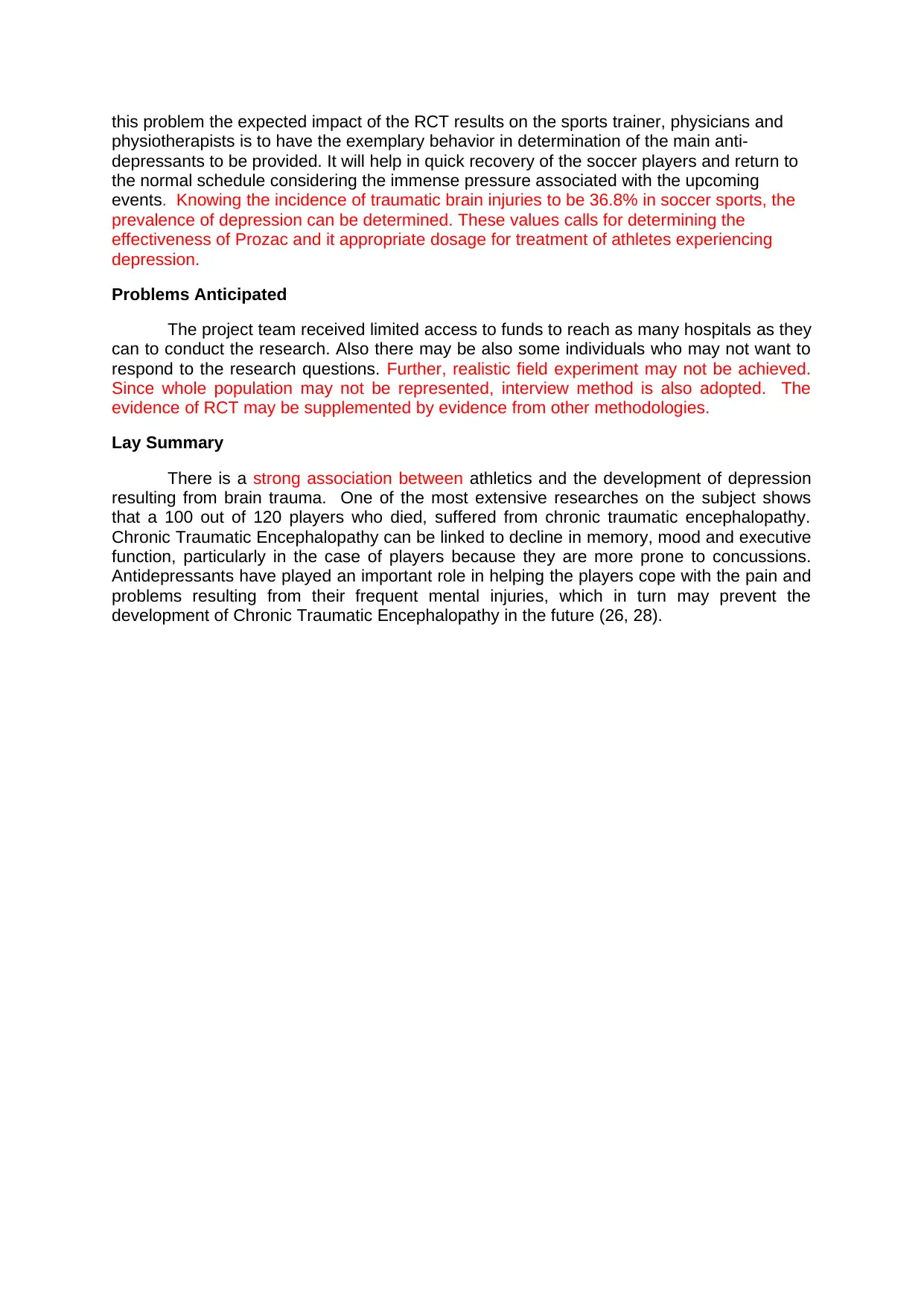
this problem the expected impact of the RCT results on the sports trainer, physicians and
physiotherapists is to have the exemplary behavior in determination of the main anti-
depressants to be provided. It will help in quick recovery of the soccer players and return to
the normal schedule considering the immense pressure associated with the upcoming
events. Knowing the incidence of traumatic brain injuries to be 36.8% in soccer sports, the
prevalence of depression can be determined. These values calls for determining the
effectiveness of Prozac and it appropriate dosage for treatment of athletes experiencing
depression.
Problems Anticipated
The project team received limited access to funds to reach as many hospitals as they
can to conduct the research. Also there may be also some individuals who may not want to
respond to the research questions. Further, realistic field experiment may not be achieved.
Since whole population may not be represented, interview method is also adopted. The
evidence of RCT may be supplemented by evidence from other methodologies.
Lay Summary
There is a strong association between athletics and the development of depression
resulting from brain trauma. One of the most extensive researches on the subject shows
that a 100 out of 120 players who died, suffered from chronic traumatic encephalopathy.
Chronic Traumatic Encephalopathy can be linked to decline in memory, mood and executive
function, particularly in the case of players because they are more prone to concussions.
Antidepressants have played an important role in helping the players cope with the pain and
problems resulting from their frequent mental injuries, which in turn may prevent the
development of Chronic Traumatic Encephalopathy in the future (26, 28).
physiotherapists is to have the exemplary behavior in determination of the main anti-
depressants to be provided. It will help in quick recovery of the soccer players and return to
the normal schedule considering the immense pressure associated with the upcoming
events. Knowing the incidence of traumatic brain injuries to be 36.8% in soccer sports, the
prevalence of depression can be determined. These values calls for determining the
effectiveness of Prozac and it appropriate dosage for treatment of athletes experiencing
depression.
Problems Anticipated
The project team received limited access to funds to reach as many hospitals as they
can to conduct the research. Also there may be also some individuals who may not want to
respond to the research questions. Further, realistic field experiment may not be achieved.
Since whole population may not be represented, interview method is also adopted. The
evidence of RCT may be supplemented by evidence from other methodologies.
Lay Summary
There is a strong association between athletics and the development of depression
resulting from brain trauma. One of the most extensive researches on the subject shows
that a 100 out of 120 players who died, suffered from chronic traumatic encephalopathy.
Chronic Traumatic Encephalopathy can be linked to decline in memory, mood and executive
function, particularly in the case of players because they are more prone to concussions.
Antidepressants have played an important role in helping the players cope with the pain and
problems resulting from their frequent mental injuries, which in turn may prevent the
development of Chronic Traumatic Encephalopathy in the future (26, 28).
Paraphrase This Document
Need a fresh take? Get an instant paraphrase of this document with our AI Paraphraser
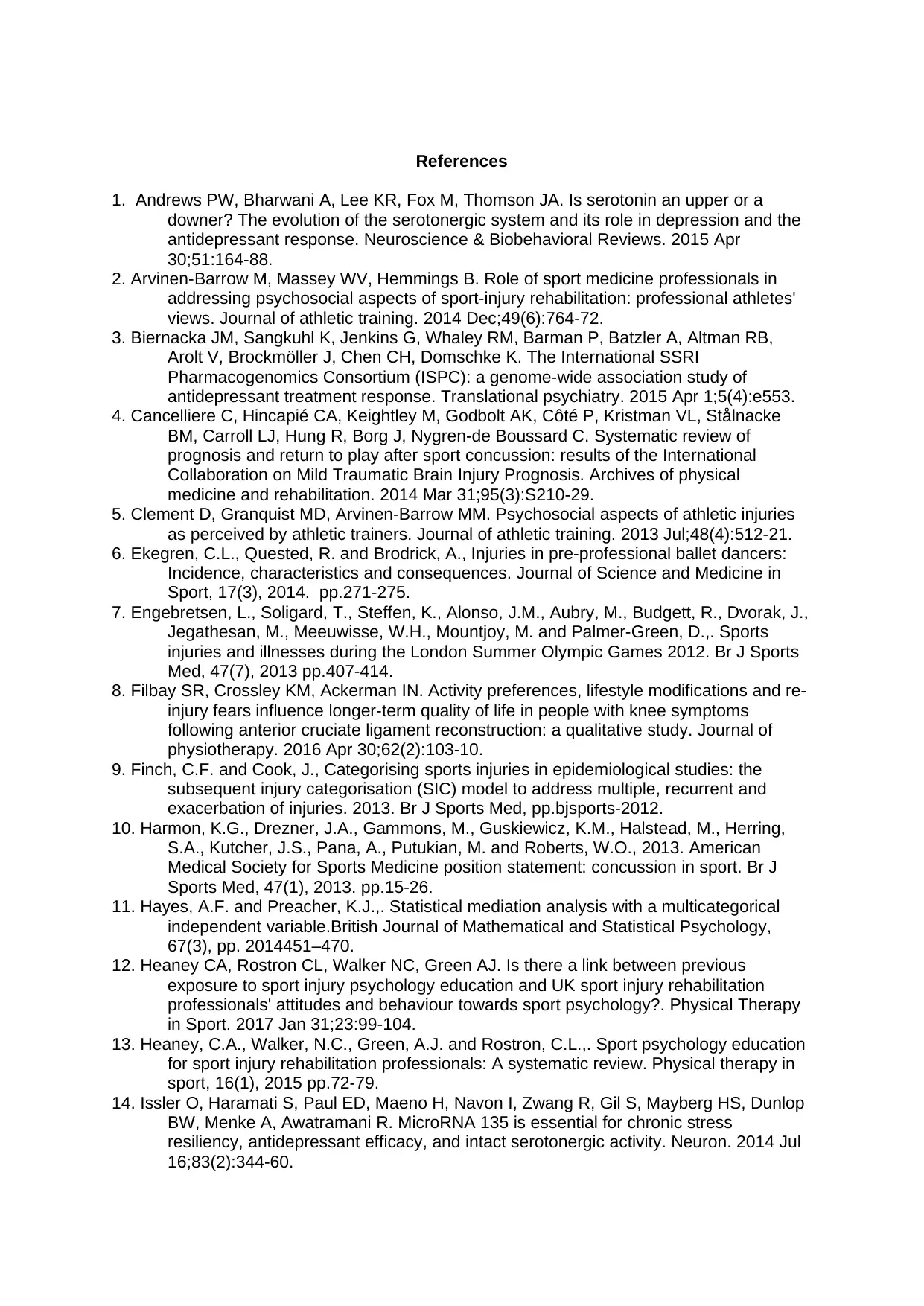
References
1. Andrews PW, Bharwani A, Lee KR, Fox M, Thomson JA. Is serotonin an upper or a
downer? The evolution of the serotonergic system and its role in depression and the
antidepressant response. Neuroscience & Biobehavioral Reviews. 2015 Apr
30;51:164-88.
2. Arvinen-Barrow M, Massey WV, Hemmings B. Role of sport medicine professionals in
addressing psychosocial aspects of sport-injury rehabilitation: professional athletes'
views. Journal of athletic training. 2014 Dec;49(6):764-72.
3. Biernacka JM, Sangkuhl K, Jenkins G, Whaley RM, Barman P, Batzler A, Altman RB,
Arolt V, Brockmöller J, Chen CH, Domschke K. The International SSRI
Pharmacogenomics Consortium (ISPC): a genome-wide association study of
antidepressant treatment response. Translational psychiatry. 2015 Apr 1;5(4):e553.
4. Cancelliere C, Hincapié CA, Keightley M, Godbolt AK, Côté P, Kristman VL, Stålnacke
BM, Carroll LJ, Hung R, Borg J, Nygren-de Boussard C. Systematic review of
prognosis and return to play after sport concussion: results of the International
Collaboration on Mild Traumatic Brain Injury Prognosis. Archives of physical
medicine and rehabilitation. 2014 Mar 31;95(3):S210-29.
5. Clement D, Granquist MD, Arvinen-Barrow MM. Psychosocial aspects of athletic injuries
as perceived by athletic trainers. Journal of athletic training. 2013 Jul;48(4):512-21.
6. Ekegren, C.L., Quested, R. and Brodrick, A., Injuries in pre-professional ballet dancers:
Incidence, characteristics and consequences. Journal of Science and Medicine in
Sport, 17(3), 2014. pp.271-275.
7. Engebretsen, L., Soligard, T., Steffen, K., Alonso, J.M., Aubry, M., Budgett, R., Dvorak, J.,
Jegathesan, M., Meeuwisse, W.H., Mountjoy, M. and Palmer-Green, D.,. Sports
injuries and illnesses during the London Summer Olympic Games 2012. Br J Sports
Med, 47(7), 2013 pp.407-414.
8. Filbay SR, Crossley KM, Ackerman IN. Activity preferences, lifestyle modifications and re-
injury fears influence longer-term quality of life in people with knee symptoms
following anterior cruciate ligament reconstruction: a qualitative study. Journal of
physiotherapy. 2016 Apr 30;62(2):103-10.
9. Finch, C.F. and Cook, J., Categorising sports injuries in epidemiological studies: the
subsequent injury categorisation (SIC) model to address multiple, recurrent and
exacerbation of injuries. 2013. Br J Sports Med, pp.bjsports-2012.
10. Harmon, K.G., Drezner, J.A., Gammons, M., Guskiewicz, K.M., Halstead, M., Herring,
S.A., Kutcher, J.S., Pana, A., Putukian, M. and Roberts, W.O., 2013. American
Medical Society for Sports Medicine position statement: concussion in sport. Br J
Sports Med, 47(1), 2013. pp.15-26.
11. Hayes, A.F. and Preacher, K.J.,. Statistical mediation analysis with a multicategorical
independent variable.British Journal of Mathematical and Statistical Psychology,
67(3), pp. 2014451–470.
12. Heaney CA, Rostron CL, Walker NC, Green AJ. Is there a link between previous
exposure to sport injury psychology education and UK sport injury rehabilitation
professionals' attitudes and behaviour towards sport psychology?. Physical Therapy
in Sport. 2017 Jan 31;23:99-104.
13. Heaney, C.A., Walker, N.C., Green, A.J. and Rostron, C.L.,. Sport psychology education
for sport injury rehabilitation professionals: A systematic review. Physical therapy in
sport, 16(1), 2015 pp.72-79.
14. Issler O, Haramati S, Paul ED, Maeno H, Navon I, Zwang R, Gil S, Mayberg HS, Dunlop
BW, Menke A, Awatramani R. MicroRNA 135 is essential for chronic stress
resiliency, antidepressant efficacy, and intact serotonergic activity. Neuron. 2014 Jul
16;83(2):344-60.
1. Andrews PW, Bharwani A, Lee KR, Fox M, Thomson JA. Is serotonin an upper or a
downer? The evolution of the serotonergic system and its role in depression and the
antidepressant response. Neuroscience & Biobehavioral Reviews. 2015 Apr
30;51:164-88.
2. Arvinen-Barrow M, Massey WV, Hemmings B. Role of sport medicine professionals in
addressing psychosocial aspects of sport-injury rehabilitation: professional athletes'
views. Journal of athletic training. 2014 Dec;49(6):764-72.
3. Biernacka JM, Sangkuhl K, Jenkins G, Whaley RM, Barman P, Batzler A, Altman RB,
Arolt V, Brockmöller J, Chen CH, Domschke K. The International SSRI
Pharmacogenomics Consortium (ISPC): a genome-wide association study of
antidepressant treatment response. Translational psychiatry. 2015 Apr 1;5(4):e553.
4. Cancelliere C, Hincapié CA, Keightley M, Godbolt AK, Côté P, Kristman VL, Stålnacke
BM, Carroll LJ, Hung R, Borg J, Nygren-de Boussard C. Systematic review of
prognosis and return to play after sport concussion: results of the International
Collaboration on Mild Traumatic Brain Injury Prognosis. Archives of physical
medicine and rehabilitation. 2014 Mar 31;95(3):S210-29.
5. Clement D, Granquist MD, Arvinen-Barrow MM. Psychosocial aspects of athletic injuries
as perceived by athletic trainers. Journal of athletic training. 2013 Jul;48(4):512-21.
6. Ekegren, C.L., Quested, R. and Brodrick, A., Injuries in pre-professional ballet dancers:
Incidence, characteristics and consequences. Journal of Science and Medicine in
Sport, 17(3), 2014. pp.271-275.
7. Engebretsen, L., Soligard, T., Steffen, K., Alonso, J.M., Aubry, M., Budgett, R., Dvorak, J.,
Jegathesan, M., Meeuwisse, W.H., Mountjoy, M. and Palmer-Green, D.,. Sports
injuries and illnesses during the London Summer Olympic Games 2012. Br J Sports
Med, 47(7), 2013 pp.407-414.
8. Filbay SR, Crossley KM, Ackerman IN. Activity preferences, lifestyle modifications and re-
injury fears influence longer-term quality of life in people with knee symptoms
following anterior cruciate ligament reconstruction: a qualitative study. Journal of
physiotherapy. 2016 Apr 30;62(2):103-10.
9. Finch, C.F. and Cook, J., Categorising sports injuries in epidemiological studies: the
subsequent injury categorisation (SIC) model to address multiple, recurrent and
exacerbation of injuries. 2013. Br J Sports Med, pp.bjsports-2012.
10. Harmon, K.G., Drezner, J.A., Gammons, M., Guskiewicz, K.M., Halstead, M., Herring,
S.A., Kutcher, J.S., Pana, A., Putukian, M. and Roberts, W.O., 2013. American
Medical Society for Sports Medicine position statement: concussion in sport. Br J
Sports Med, 47(1), 2013. pp.15-26.
11. Hayes, A.F. and Preacher, K.J.,. Statistical mediation analysis with a multicategorical
independent variable.British Journal of Mathematical and Statistical Psychology,
67(3), pp. 2014451–470.
12. Heaney CA, Rostron CL, Walker NC, Green AJ. Is there a link between previous
exposure to sport injury psychology education and UK sport injury rehabilitation
professionals' attitudes and behaviour towards sport psychology?. Physical Therapy
in Sport. 2017 Jan 31;23:99-104.
13. Heaney, C.A., Walker, N.C., Green, A.J. and Rostron, C.L.,. Sport psychology education
for sport injury rehabilitation professionals: A systematic review. Physical therapy in
sport, 16(1), 2015 pp.72-79.
14. Issler O, Haramati S, Paul ED, Maeno H, Navon I, Zwang R, Gil S, Mayberg HS, Dunlop
BW, Menke A, Awatramani R. MicroRNA 135 is essential for chronic stress
resiliency, antidepressant efficacy, and intact serotonergic activity. Neuron. 2014 Jul
16;83(2):344-60.
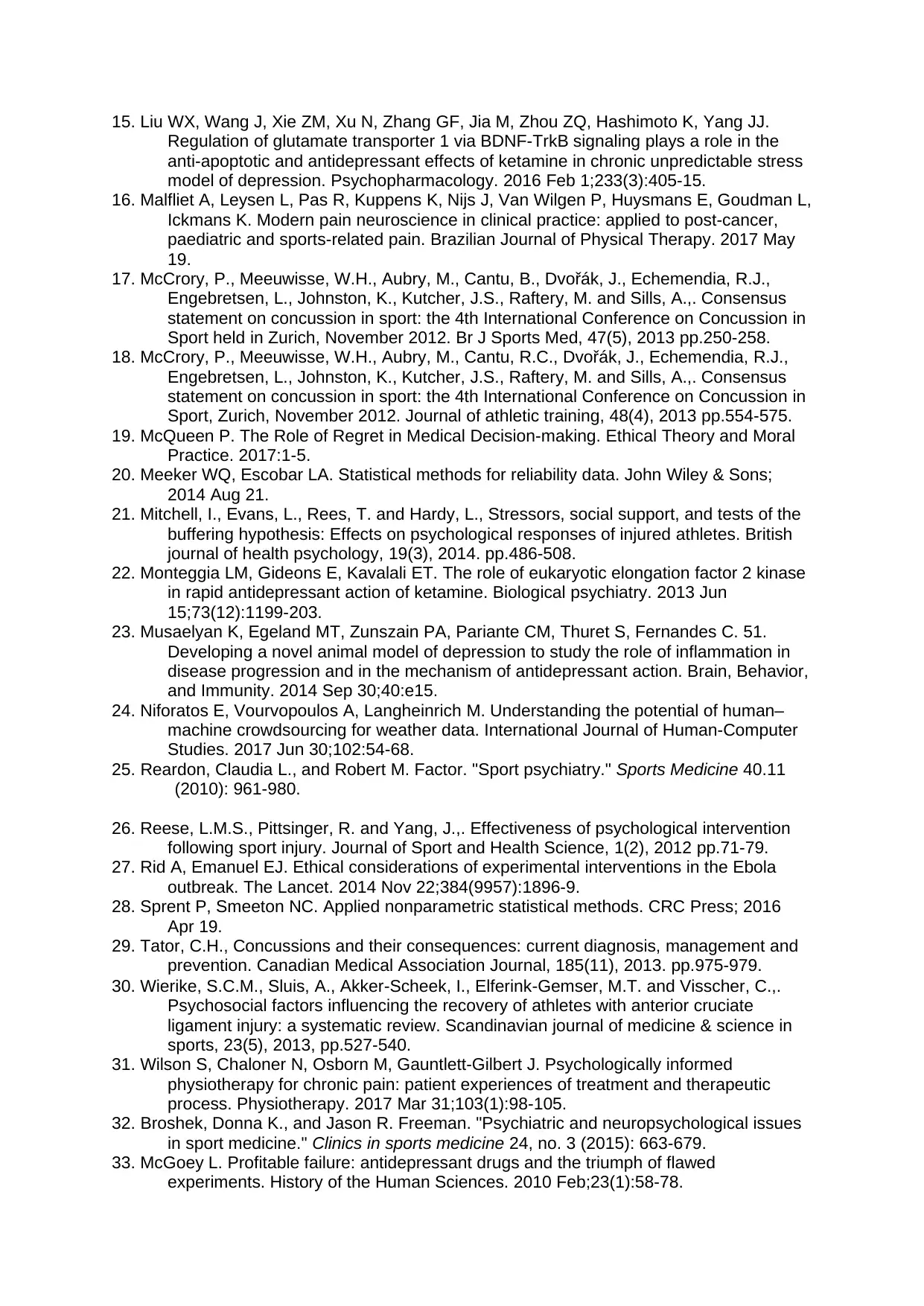
15. Liu WX, Wang J, Xie ZM, Xu N, Zhang GF, Jia M, Zhou ZQ, Hashimoto K, Yang JJ.
Regulation of glutamate transporter 1 via BDNF-TrkB signaling plays a role in the
anti-apoptotic and antidepressant effects of ketamine in chronic unpredictable stress
model of depression. Psychopharmacology. 2016 Feb 1;233(3):405-15.
16. Malfliet A, Leysen L, Pas R, Kuppens K, Nijs J, Van Wilgen P, Huysmans E, Goudman L,
Ickmans K. Modern pain neuroscience in clinical practice: applied to post-cancer,
paediatric and sports-related pain. Brazilian Journal of Physical Therapy. 2017 May
19.
17. McCrory, P., Meeuwisse, W.H., Aubry, M., Cantu, B., Dvořák, J., Echemendia, R.J.,
Engebretsen, L., Johnston, K., Kutcher, J.S., Raftery, M. and Sills, A.,. Consensus
statement on concussion in sport: the 4th International Conference on Concussion in
Sport held in Zurich, November 2012. Br J Sports Med, 47(5), 2013 pp.250-258.
18. McCrory, P., Meeuwisse, W.H., Aubry, M., Cantu, R.C., Dvořák, J., Echemendia, R.J.,
Engebretsen, L., Johnston, K., Kutcher, J.S., Raftery, M. and Sills, A.,. Consensus
statement on concussion in sport: the 4th International Conference on Concussion in
Sport, Zurich, November 2012. Journal of athletic training, 48(4), 2013 pp.554-575.
19. McQueen P. The Role of Regret in Medical Decision-making. Ethical Theory and Moral
Practice. 2017:1-5.
20. Meeker WQ, Escobar LA. Statistical methods for reliability data. John Wiley & Sons;
2014 Aug 21.
21. Mitchell, I., Evans, L., Rees, T. and Hardy, L., Stressors, social support, and tests of the
buffering hypothesis: Effects on psychological responses of injured athletes. British
journal of health psychology, 19(3), 2014. pp.486-508.
22. Monteggia LM, Gideons E, Kavalali ET. The role of eukaryotic elongation factor 2 kinase
in rapid antidepressant action of ketamine. Biological psychiatry. 2013 Jun
15;73(12):1199-203.
23. Musaelyan K, Egeland MT, Zunszain PA, Pariante CM, Thuret S, Fernandes C. 51.
Developing a novel animal model of depression to study the role of inflammation in
disease progression and in the mechanism of antidepressant action. Brain, Behavior,
and Immunity. 2014 Sep 30;40:e15.
24. Niforatos E, Vourvopoulos A, Langheinrich M. Understanding the potential of human–
machine crowdsourcing for weather data. International Journal of Human-Computer
Studies. 2017 Jun 30;102:54-68.
25. Reardon, Claudia L., and Robert M. Factor. "Sport psychiatry." Sports Medicine 40.11
(2010): 961-980.
26. Reese, L.M.S., Pittsinger, R. and Yang, J.,. Effectiveness of psychological intervention
following sport injury. Journal of Sport and Health Science, 1(2), 2012 pp.71-79.
27. Rid A, Emanuel EJ. Ethical considerations of experimental interventions in the Ebola
outbreak. The Lancet. 2014 Nov 22;384(9957):1896-9.
28. Sprent P, Smeeton NC. Applied nonparametric statistical methods. CRC Press; 2016
Apr 19.
29. Tator, C.H., Concussions and their consequences: current diagnosis, management and
prevention. Canadian Medical Association Journal, 185(11), 2013. pp.975-979.
30. Wierike, S.C.M., Sluis, A., Akker‐Scheek, I., Elferink‐Gemser, M.T. and Visscher, C.,.
Psychosocial factors influencing the recovery of athletes with anterior cruciate
ligament injury: a systematic review. Scandinavian journal of medicine & science in
sports, 23(5), 2013, pp.527-540.
31. Wilson S, Chaloner N, Osborn M, Gauntlett-Gilbert J. Psychologically informed
physiotherapy for chronic pain: patient experiences of treatment and therapeutic
process. Physiotherapy. 2017 Mar 31;103(1):98-105.
32. Broshek, Donna K., and Jason R. Freeman. "Psychiatric and neuropsychological issues
in sport medicine." Clinics in sports medicine 24, no. 3 (2015): 663-679.
33. McGoey L. Profitable failure: antidepressant drugs and the triumph of flawed
experiments. History of the Human Sciences. 2010 Feb;23(1):58-78.
Regulation of glutamate transporter 1 via BDNF-TrkB signaling plays a role in the
anti-apoptotic and antidepressant effects of ketamine in chronic unpredictable stress
model of depression. Psychopharmacology. 2016 Feb 1;233(3):405-15.
16. Malfliet A, Leysen L, Pas R, Kuppens K, Nijs J, Van Wilgen P, Huysmans E, Goudman L,
Ickmans K. Modern pain neuroscience in clinical practice: applied to post-cancer,
paediatric and sports-related pain. Brazilian Journal of Physical Therapy. 2017 May
19.
17. McCrory, P., Meeuwisse, W.H., Aubry, M., Cantu, B., Dvořák, J., Echemendia, R.J.,
Engebretsen, L., Johnston, K., Kutcher, J.S., Raftery, M. and Sills, A.,. Consensus
statement on concussion in sport: the 4th International Conference on Concussion in
Sport held in Zurich, November 2012. Br J Sports Med, 47(5), 2013 pp.250-258.
18. McCrory, P., Meeuwisse, W.H., Aubry, M., Cantu, R.C., Dvořák, J., Echemendia, R.J.,
Engebretsen, L., Johnston, K., Kutcher, J.S., Raftery, M. and Sills, A.,. Consensus
statement on concussion in sport: the 4th International Conference on Concussion in
Sport, Zurich, November 2012. Journal of athletic training, 48(4), 2013 pp.554-575.
19. McQueen P. The Role of Regret in Medical Decision-making. Ethical Theory and Moral
Practice. 2017:1-5.
20. Meeker WQ, Escobar LA. Statistical methods for reliability data. John Wiley & Sons;
2014 Aug 21.
21. Mitchell, I., Evans, L., Rees, T. and Hardy, L., Stressors, social support, and tests of the
buffering hypothesis: Effects on psychological responses of injured athletes. British
journal of health psychology, 19(3), 2014. pp.486-508.
22. Monteggia LM, Gideons E, Kavalali ET. The role of eukaryotic elongation factor 2 kinase
in rapid antidepressant action of ketamine. Biological psychiatry. 2013 Jun
15;73(12):1199-203.
23. Musaelyan K, Egeland MT, Zunszain PA, Pariante CM, Thuret S, Fernandes C. 51.
Developing a novel animal model of depression to study the role of inflammation in
disease progression and in the mechanism of antidepressant action. Brain, Behavior,
and Immunity. 2014 Sep 30;40:e15.
24. Niforatos E, Vourvopoulos A, Langheinrich M. Understanding the potential of human–
machine crowdsourcing for weather data. International Journal of Human-Computer
Studies. 2017 Jun 30;102:54-68.
25. Reardon, Claudia L., and Robert M. Factor. "Sport psychiatry." Sports Medicine 40.11
(2010): 961-980.
26. Reese, L.M.S., Pittsinger, R. and Yang, J.,. Effectiveness of psychological intervention
following sport injury. Journal of Sport and Health Science, 1(2), 2012 pp.71-79.
27. Rid A, Emanuel EJ. Ethical considerations of experimental interventions in the Ebola
outbreak. The Lancet. 2014 Nov 22;384(9957):1896-9.
28. Sprent P, Smeeton NC. Applied nonparametric statistical methods. CRC Press; 2016
Apr 19.
29. Tator, C.H., Concussions and their consequences: current diagnosis, management and
prevention. Canadian Medical Association Journal, 185(11), 2013. pp.975-979.
30. Wierike, S.C.M., Sluis, A., Akker‐Scheek, I., Elferink‐Gemser, M.T. and Visscher, C.,.
Psychosocial factors influencing the recovery of athletes with anterior cruciate
ligament injury: a systematic review. Scandinavian journal of medicine & science in
sports, 23(5), 2013, pp.527-540.
31. Wilson S, Chaloner N, Osborn M, Gauntlett-Gilbert J. Psychologically informed
physiotherapy for chronic pain: patient experiences of treatment and therapeutic
process. Physiotherapy. 2017 Mar 31;103(1):98-105.
32. Broshek, Donna K., and Jason R. Freeman. "Psychiatric and neuropsychological issues
in sport medicine." Clinics in sports medicine 24, no. 3 (2015): 663-679.
33. McGoey L. Profitable failure: antidepressant drugs and the triumph of flawed
experiments. History of the Human Sciences. 2010 Feb;23(1):58-78.
⊘ This is a preview!⊘
Do you want full access?
Subscribe today to unlock all pages.

Trusted by 1+ million students worldwide
1 out of 13
Related Documents
Your All-in-One AI-Powered Toolkit for Academic Success.
+13062052269
info@desklib.com
Available 24*7 on WhatsApp / Email
![[object Object]](/_next/static/media/star-bottom.7253800d.svg)
Unlock your academic potential
Copyright © 2020–2025 A2Z Services. All Rights Reserved. Developed and managed by ZUCOL.




